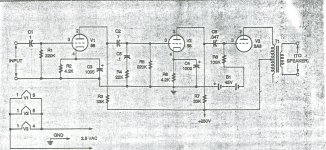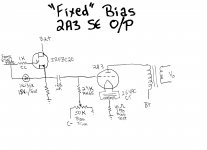Hi,
I am collecting the parts needed for a 2a3 build. The schematic I have uses 2 Type 56 triode driver tubes for the 2a3. I have reviewed many of the drawing on this site and elseware, yet have not seen one using these tubes as drivers. Must be a good reason? Does anyone know about this?
thanks!
Ron
I am collecting the parts needed for a 2a3 build. The schematic I have uses 2 Type 56 triode driver tubes for the 2a3. I have reviewed many of the drawing on this site and elseware, yet have not seen one using these tubes as drivers. Must be a good reason? Does anyone know about this?
thanks!
Ron
I would guess that the gain of them is so low that one isn't enough to drive the 2A3 and two is too much gain for todays sources. You can get enough gain from just one triode stage with a better tube choice. Also you probably want something with an operating point that has a bit more current in front of the 2A3.
Most SE enthusiast prefer two gain stages. The 56 has such a low mu that it's a bit impractical for that. This might explain the lack of examples.
For some other tubes the 56 might be enough of a driver, but 2A3 requires such a high input that you won't get full drive out of it, with a line level input signal.
Could you post your schematic?
For some other tubes the 56 might be enough of a driver, but 2A3 requires such a high input that you won't get full drive out of it, with a line level input signal.
Could you post your schematic?
More
To MrCurwin,
Thank you for your encouragement and knowledge contribution.
I am an old guy trying to chase an old hobby.
Thanks!
Ron
To MrCurwin,
Thank you for your encouragement and knowledge contribution.
I am an old guy trying to chase an old hobby.
Thanks!
Ron
Bias
Hello FamousMockingBird,
The design that I am looking at has battery bias, I have an alternative circuit chosen using a Hammond 302AX that I would like to use.
But knowing nothing but AC/DC electric welding circuits and industrial controls
I am a retired novice trying to make something of my life with Chemo..
Just would appreciate the knowledgeable help from you all here.
Thanks!
Ron - Cleveland Ohio
Hello FamousMockingBird,
The design that I am looking at has battery bias, I have an alternative circuit chosen using a Hammond 302AX that I would like to use.
But knowing nothing but AC/DC electric welding circuits and industrial controls
I am a retired novice trying to make something of my life with Chemo..
Just would appreciate the knowledgeable help from you all here.
Thanks!
Ron - Cleveland Ohio
You can, more or less, retain the topology by using a 6SN7 twin triode for voltage amplification. The circuit shows truly fixed, battery, bias on the 2A3's grid. As DHTs, like the 2A3, are particularly vulnerable to runaway, when fixed bias is employed, I'd like to see the value of the 2A3's grid resistor reduced. To prevent voltage amplifier gain loss, insert a DC coupled IRFBC20 source follower between the voltage gain circuitry and the 2A3. Think of the FET as a heaterless pentode. For several reasons, including great ease of use, a well selected FET makes a superior voltage follower. Read MOSFET Follies. Experience has shown that protective 15 V. Zener diode between the gate and source electrodes of the IRFBC20 is important protection against start up transients.
Build a SS rectified negative supply for 2A3 bias and use trim pots., to exactly control O/P tube "idle" current.
Build a SS rectified negative supply for 2A3 bias and use trim pots., to exactly control O/P tube "idle" current.
That design will not have much low end response me thinks, and as Eli mentioned you will want to lower the 2A3 grids circuit resistance which will make matters worse.
What's the reasoning behind R4/C5?
Thanks,
Chris
I am thinking it is compensating for the lack of low end bandwidth.
Source follower driving 2A3 grid is an excellent idea, I also recommend that. The source follower gate can have a very high bias resistor, 1M is fine. This will help with the low end response wrt coupling cap.
Source follower driving 2A3 grid is an excellent idea, I also recommend that. The source follower gate can have a very high bias resistor, 1M is fine. This will help with the low end response wrt coupling cap.
No coupling cap., whatsoever, between the voltage amplification circuitry and the FET. Only a gate stopper is between the 2nd gain block's anode and the FET gate. DC coupling enhancement mode MOSFET source followers is pretty darned easy. 🙂 5 mA. of drain current will surely bring the follower's O/P impedance below 1000 Ω. A 0.68 μF. cap. coupling the source follower to the 2A3 allows that tube's grid resistor to be a safe (for "fixed" bias) 47 Kohms.
Why would you be driving the 2A3 grid thru a capacitor load with the follower, when you could simply be driving the grid with the follower?
Why would you be driving the 2A3 grid thru a capacitor load with the follower, when you could simply be driving the grid with the follower?
There are pluses and minuses to both approaches. DC coupling the FET to the voltage amplifier circuitry makes for PSU simplicity and there is no chance of dragging the 2A3's grid too far into positive territory. DC coupling the FET to the 2A3's grid allows for some A2 action and is immune to blocking distortion, but the overdrive risk is present and PSU complexity is a given. Refer to Tubelab's PowerDrive.
Summation
Hi,
Your conversation has been very interesting. So the consensus would be "It's a dog"? Or might be ok? I just wondered if there was anything to be gained by having completely separate pre-stages instead of using a dual triode up front. What is lost with this design? Is it worth building using a different bias method and trying to tweak it for better LF response? Maybe a higher b+ ?
Thanks you all for the conversation!
Ron
Hi,
Your conversation has been very interesting. So the consensus would be "It's a dog"? Or might be ok? I just wondered if there was anything to be gained by having completely separate pre-stages instead of using a dual triode up front. What is lost with this design? Is it worth building using a different bias method and trying to tweak it for better LF response? Maybe a higher b+ ?
Thanks you all for the conversation!
Ron
IMO, there's nothing gained by using 2 bottles, instead of a single twin triode. Given shorter wiring paths, the twin triode might be better.
The basic topology of 2X medium μ voltage gain stages is sound and has been used with considerable success, but some details will need tweaking. Perhaps 1 of the members has the schematic Ron Welborne used, years ago, before he fell from grace.
The triode in the 6SN7 is a prime contender for the most linear voltage amplifying device, of all time. Size the interstage coupling caps. correctly, along with decent O/P "iron", and the amp will yield good bass extension.
I'll work up a "hen scratch" schematic for the FET buffer and O/P stage. It will be uploaded, soon.
The basic topology of 2X medium μ voltage gain stages is sound and has been used with considerable success, but some details will need tweaking. Perhaps 1 of the members has the schematic Ron Welborne used, years ago, before he fell from grace.
The triode in the 6SN7 is a prime contender for the most linear voltage amplifying device, of all time. Size the interstage coupling caps. correctly, along with decent O/P "iron", and the amp will yield good bass extension.
I'll work up a "hen scratch" schematic for the FET buffer and O/P stage. It will be uploaded, soon.
I recommend you 24A in pentode. Very nice sound and need only one stage.
http://vinsluh.org.ua/24a-2a3/
http://vinsluh.org.ua/24a-2a3/
Hi,
Here is what I am planning on for my build. It seems simple with a minimum of components. Seems a good start for me. Please throw in all your advise.
Thanks for your help!!!
Ron
Eli brought us very good suggestions in terms of practicality especially with using the IRFbc20 FET which makes its easier on the driver to do its job.
If I was going to 2A3 set amp of simplistic design,I would be using an ECC99 or a 5687 driver and you can share one driver for both channels. Here is a design that is wide bandwidth which is what I like for modern speakers. Take a look. Eli can come up with tuning suggestions on this as well but this also has the power supply schematic.I have a pair of mono sets that using a 5687 into a 310a driving 300b in single ended and its very dynamic. This can be sourced from surplus parts from Ebay or hamfests or junk boxes all except for the output trafos.
http://www.hagtech.com/pdf/clarionarticle.pdf
Last edited:
- Status
- Not open for further replies.
- Home
- Amplifiers
- Tubes / Valves
- 2A3 driver

